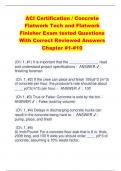ACI Certification / Concrete
Flatwork Tech and Flatwork
Finisher Exam tested Questions
With Correct Reviewed Answers
Chapter #1-#10
(Ch. 1, #1) It is important that the _______ _______ read
and understand project specifications - ANSWER ✔ :
finishing foreman
(Ch. 1, #2) If the crew can place and finish 100yd^3 (m^3)
of concrete per hour, the producer's rate should be about
____ yd^3(m^3) per hour. - ANSWER ✔ : 100
(Ch 1, #3) True or False: Concrete is sold by the ton. -
ANSWER ✔ : False (sold by volume)
(Ch. 1, #4) Delays in discharging concrete trucks can
result in the concrete being hard to: - ANSWER ✔ :
pump, place, and finish
(Ch. 1, #5)
A) Inch/Pound: For a concrete floor slab that is 6 in. thick,
200ft long, and 100 ft wide you should order ____ yd^3 of
concrete, assuming a 10% waste factor.
,B) Metric: For a concrete floor slab that is 150 mm thick,
60 m long, and 30 m wide you should order ____ m^3 of
concrete, assuming a 10% waste factor. - ANSWER ✔ :
A) 407.41; B) 297
(Ch. 1, #6) When there is room for two concrete trucks
ready to discharge into a pump hopper, placement is
faster because: - ANSWER ✔ : as one truck is finishing,
the other is ready to unload concrete
(Ch. 1, #7) Concrete from a ready mix truck must be
completely discharged within ____ hours after water has
been added at the plant. - ANSWER ✔ : 1.5
(Ch. 1, #8) You can tell when water was added to the
concrete truck by looking at the: - ANSWER ✔ : batch
ticket
(Ch. 1, #9) When concrete for a slab placement will be
discharged from the truck chute, truck arrivals should
usually be spaced about: - ANSWER ✔ : 15 minutes
(Ch. 1, #10) True or False: When finishers get behind
because the concrete is setting faster than expected and
the placing crew is also shorthanded, one solution is
slowing the concrete delivery rate to match worker output.
- ANSWER ✔ : True
(Ch. 1, #11) True or False: In deciding how much
concrete to order for a floor placement, you should
,calculate the number of cubic yards (cubic meters) needed
to fill the forms, then order two or three cubic yards (cubic
meters) less so you don't waste concrete that is not
needed. - ANSWER ✔ : False (Standard is to order 10%
to 15% *more* than measured volume for small orders
and 5 to 10% more than measured volume for large orders
to account for subgrade settlement, uneven subgrade,
spillage, and waste.)
(Ch. 1, #12) The question "What finisher or finishers can
request the addition of water to the concrete truck on
site?" Should be answered at the _________
__________. - ANSWER ✔ : preconstruction conference
(Ch. 2, #1) True or False: Concrete made with portland
cement will set and harden while underwater. - ANSWER
✔ : True
(Ch. 2, #2) If a concrete slab on ground won't be exposed
to sulfates, the cement used is most likely to be: -
ANSWER ✔ : Type I
(Ch. 2, #3) Fly ash may be added to concrete from a fly
ash silo at the batch plant or from a silo containing a
_______ cement. - ANSWER ✔ : portland
(Ch. 2, #4) Most concrete used in slabs on ground has
course aggregate with a maximum size of: - ANSWER ✔ :
0.75 to 1.5 in. (19 to 38 mm.)
, (Ch. 2, #5) True or False: Sand for concrete used in slabs
on ground is easier to finish when it has close to the
largest allowable amount of material passing the No. 50
and No. 100 sieves. - ANSWER ✔ : True
(Ch. 2, #6) True or False: Increasing the amount of sand
in a concrete usually decreases the amount of water
needed to make the concrete workable. - ANSWER ✔ :
False (Too many small particles will *increase* the amount
of water needed to make the concrete workable.)
(Ch. 2, #7) All concrete that will be subject to freezing
when moist or be exposed to deicing salts should contain:
- ANSWER ✔ : an air-entraining agent
(Ch. 2, #8) Strength of normal weight concrete depends
mainly on: - ANSWER ✔ : water-cement ratio
(Ch. 2, #9) True or False: Oversanded concrete mixtures
are likely to produce floors with poor wear resistance and
excessive shrinkage. - ANSWER ✔ : True
(Ch. 2, #10) To minimize shrinkage and reduce cracking
and curling: - ANSWER ✔ : Use as much coarse
aggregate as possible, as little mixing water as possible,
and use aggregates with low shrinkage.
(Ch. 2, #11) Changes in concrete slump most often
represent changes in the amount of ______ in the mixture.
- ANSWER ✔ : water




